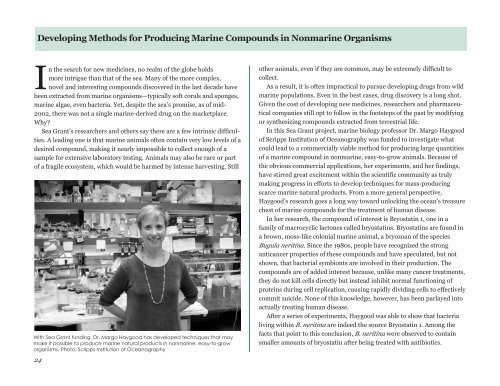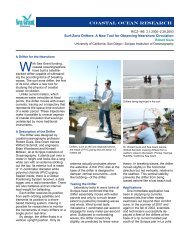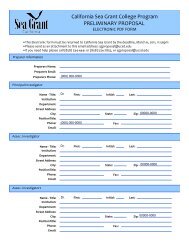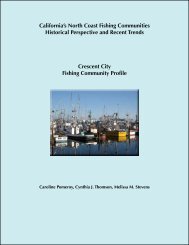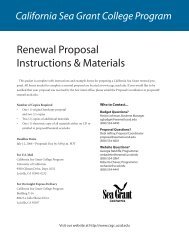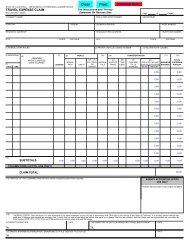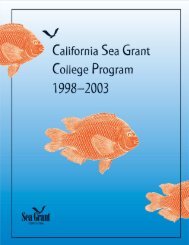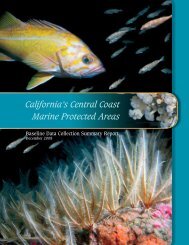2001â2002 - California Sea Grant - UC San Diego
2001â2002 - California Sea Grant - UC San Diego
2001â2002 - California Sea Grant - UC San Diego
You also want an ePaper? Increase the reach of your titles
YUMPU automatically turns print PDFs into web optimized ePapers that Google loves.
Developing Methods for Producing Marine Compounds in Nonmarine Organisms<br />
In the search for new medicines, no realm of the globe holds<br />
more intrigue than that of the sea. Many of the more complex,<br />
novel and interesting compounds discovered in the last decade have<br />
been extracted from marine organisms—typically soft corals and sponges,<br />
marine algae, even bacteria. Yet, despite the sea’s promise, as of mid-<br />
2002, there was not a single marine-derived drug on the marketplace.<br />
Why?<br />
<strong>Sea</strong> <strong>Grant</strong>’s researchers and others say there are a few intrinsic difficulties.<br />
A leading one is that marine animals often contain very low levels of a<br />
desired compound, making it nearly impossible to collect enough of a<br />
sample for extensive laboratory testing. Animals may also be rare or part<br />
of a fragile ecosystem, which would be harmed by intense harvesting. Still<br />
With <strong>Sea</strong> <strong>Grant</strong> funding, Dr. Margo Haygood has developed techniques that may<br />
make it possible to produce marine natural products in nonmarine, easy-to-grow<br />
organisms. Photo: Scripps Institution of Oceanography<br />
24<br />
other animals, even if they are common, may be extremely difficult to<br />
collect.<br />
As a result, it is often impractical to pursue developing drugs from wild<br />
marine populations. Even in the best cases, drug discovery is a long shot.<br />
Given the cost of developing new medicines, researchers and pharmaceutical<br />
companies still opt to follow in the footsteps of the past by modifying<br />
or synthesizing compounds extracted from terrestrial life.<br />
In this <strong>Sea</strong> <strong>Grant</strong> project, marine biology professor Dr. Margo Haygood<br />
of Scripps Institution of Oceanography was funded to investigate what<br />
could lead to a commercially viable method for producing large quantities<br />
of a marine compound in nonmarine, easy-to-grow animals. Because of<br />
the obvious commercial applications, her experiments, and her findings,<br />
have stirred great excitement within the scientific community as truly<br />
making progress in efforts to develop techniques for mass-producing<br />
scarce marine natural products. From a more general perspective,<br />
Haygood’s research goes a long way toward unlocking the ocean’s treasure<br />
chest of marine compounds for the treatment of human disease.<br />
In her research, the compound of interest is Bryostatin 1, one in a<br />
family of macrocyclic lactones called bryostatins. Bryostatins are found in<br />
a brown, moss-like colonial marine animal, a bryozoan of the species<br />
Bugula neritina. Since the 1980s, people have recognized the strong<br />
anticancer properties of these compounds and have speculated, but not<br />
shown, that bacterial symbionts are involved in their production. The<br />
compounds are of added interest because, unlike many cancer treatments,<br />
they do not kill cells directly but instead inhibit normal functioning of<br />
proteins during cell replication, causing rapidly dividing cells to effectively<br />
commit suicide. None of this knowledge, however, has been parlayed into<br />
actually treating human disease.<br />
After a series of experiments, Haygood was able to show that bacteria<br />
living within B. neritina are indeed the source Bryostatin 1. Among the<br />
facts that point to this conclusion, B. neritina were observed to contain<br />
smaller amounts of bryostatin after being treated with antibiotics.


